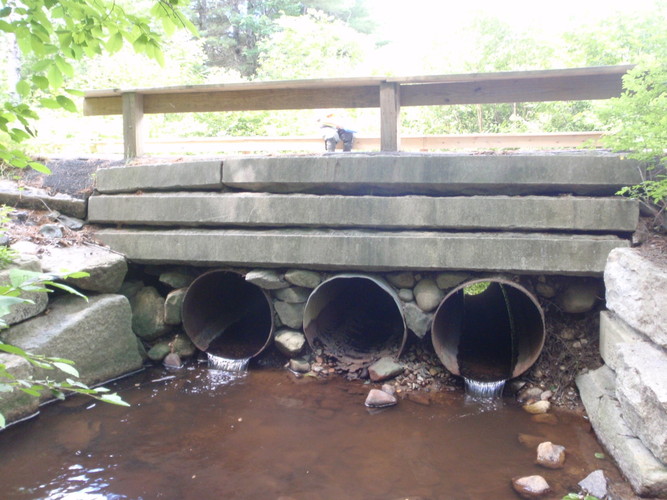The Wrack
The Wrack is the Wells Reserve blog, our collective logbook on the web.
The Wrack is the Wells Reserve blog, our collective logbook on the web.
Since 2010, the Wells Reserve has been working with partners to develop an inventory of stream barriers in the small coastal watersheds of York County. These are usually man-made structures that prevent the upstream or downstream movement of fish and other aquatic organisms, due to the fact that stream crossings were not historically designed with fish in mind. The impacts of stream barriers are particularly severe on migratory fish such alewives or salmon, which move from the ocean into rivers to reproduce.
Barriers at stream crossings are often a result of the structure being too small. Undersized crossings increase the velocity of the stream as it passes through, and this can cause scouring at the crossing outlet, which can lead to the outlet becoming perched as the water level below it drops. Increased stream velocity also acts as a barrier for weak swimmers such as rainbow smelt.

Perched culverts at a stream crossing create a barrier to aquatic organisms
To locate stream barriers, staff and volunteers survey potential barriers at stream crossings on roads, trails, and railways, as well as dams and natural barriers such as waterfalls. Wells Reserve uses a survey protocol developed by the USFWS Gulf of Maine Coastal Program.
After locating stream barriers, the Wells Reserve works with road managers to identify restoration projects that will achieve a positive outcome for the ecology of the stream. In some cases, replacement of an undersized culvert with a larger one will also increase the lifespan of the crossing and reduce long term maintenance costs associated with failed structures. Proactive crossing replacement could could also create a more resilient road system and improved stream habitat conditions.
Wells Reserve Stream Barrier Inventory — A quick reference guide to barriers surveyed by Wells NERR (updated April 2014).
2012 Stream Barrier Survey Report — Results and recommendations from the 2012 barrier surveys in the Kennebunk River, Shorey's Brook, and MBLR watersheds.
2010 Kennebunk River Road-Stream Crossing Survey Report — Results and recommendations from the 2010 barrier survey in the Kennebunk River watershed.
In November 2012, the Wells Reserve hosted a workshop titled "Building Smart Road-Stream Crossings." Participants heard presentations on road crossing ecology, crossing best management practices, permitting, and crossing legislation, as well as an update on Wells Reserve stream barrier surveys.
"The Value of Stream Smart Crossings" (40 MB) — Jed Wright, USFWS Gulf of Maine Coastal Program
"How to Create Stream Smart Crossings" — Keith Kanoti, Maine Forest Service
"Stream Crossings: Where we are headed" — Mike Mullen, Maine Department of Environmental Protection
"2012 Stream Barrier Survey of the Kennebunk River, Merriland RIver, Branch Brook, and Shorey's Brook." — Jacob Aman, Wells Reserve
"Stream Crossings and Corps Permits" — Jay Clement, US Army Corps of Engineers
Funding Opportunities for Stream Smart Crossings — Maine Audubon
Stream Smart Road Crossings Workshop Resources — Maine Audubon
Technical Assistance for Stream Smart Road Crossings — Maine Audubon
Maine Stream Crossings, New Designs to Restore Stream Continuity — USFWS, NOAA, MFS
Projects Completed in Maine — USFWS, NOAA, MFS
Contacts, Online Resources, Grants — USFWS, NOAA, MFS